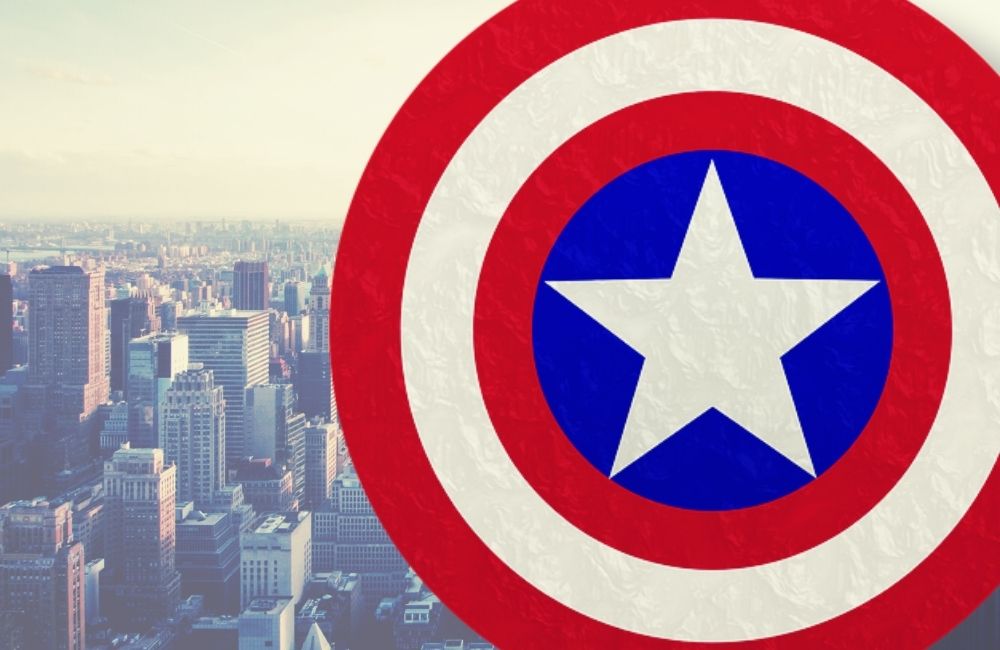Probably one of the most iconic heroes in the entire Marvel catalog, Captain America has been around since the 1940s, where he was busy punching Nazis and Hitler in the face long before he was kicking Hydra and the Red Skull’s butt into a different galaxy.

But the cap wouldn’t be the super soldier that he is without his iconic shield. Created by the senior genius, billionaire, playboy, and philanthropist Howard Stark, Captain America’s shield is made from the fictional material Vibranium, found only in the secretive Kingdom of Wakanda and is nigh-indestructible (at least, by Earthling standards).
Cap’s shield is both for defense and offense: capable of absorbing even the strongest hits from artillery shells to Hulk’s fists, even the legendary Mjolnir of Thor.

This resiliency also allows Captain America to use his shield as a weapon. Whether it’s inelegantly bashing it against someone’s skull or, more iconically, throwing it as a makeshift boomerang that ricochets from target to wall and back to the Cap. Or from wall to target then another target then maybe another wall before going back to Cap.
Look, the point is, Captain America can throw his shield and it will bounce off stuff to hit the bad guys. Is it physically impossible? Maybe. Is it cool to look at? Oh, definitely.

But is it actually physically possible? Well, setting aside discussions about the fictional properties of Vibranium, let’s focus on the physics of how Captain America’s shield behaves when thrown. Warning: there’s going to be a lot of math involved
First, Some Assumptions
Before we speculate about the physics and angles of Captain America’s shield, let’s go through some assumptions. First, we’ll disregard the traveling speed of the shield. We’ll assume that it flies more like an airplane wing, which glides rather than a metal shield which drops because it’s easier this way.
Secondly, let’s take Marvel’s definition of Vibranium as gospel truth. With that in mind, we’ll assume that the special attributes of Vibranium allow for elasticity, regardless of surface. This would mean that the shield would obey all known laws that govern physical objects bouncing against one another. To put it simply, the angle of incidence of Captain America’s shield when it hits a wall is equal to its angle of reflection.
So with all these in mind, we can now imagine Captain America’s shield traveling at a constant speed, but with its reflection off a wall dependent on the angle in which it hits. And if the wall has an off-angle that might affect its bounce. We’re also assuming that:
- The shield actually hits the wall
- There is a definite point in time and space that it hits the wall
- Its reflected velocity vector is dependent on the orientation of the wall and the velocity in which the shield hits it
Here Comes the Math
Alright, so let’s assume that there’s a wall, with its length being represented as L. It’s oriented in a straight line, with Captain America’s shield moving towards it. The first step in calculating its bounce would be to find the position of the two ends of the wall (which we will call P1 and P2) so we can have a clearer orientation.
With P1 and P2 set, we can now have reference points for calculating the distance of the shield from L based on how far P1 and P2 are from each other. The sum of these distances should equal L, if our calculations are correct:

By calculating these distances and treating them as vectors, we’ll find that the sum magnitude of r1 and r2 (in relation to the distance of P1 and P2 from Captain America’s shield) can only be equal to L IF the shield hits the center of the two end points. If it doesn’t hit dead center, then the sum magnitude will be greater than L.
Bear in mind, however, that this particular model only considers the entire scenario in two dimensions. However, upon checking with my Math teacher from 3rd grade, she said this should work in three dimensions as well (I’m taking her word for it because she’s scary). We’re also not considering the size and weight of the shield, mostly because that’s way too much Math, even for me, but if you want to torture yourself, go ahead and let me know in the comments below.
Captain America’s Shield: It Requires a Lot of Math
Now, with those in mind, and while it does work in 3-D, calculating the reflection using this model would only show us 2-D results as the shield moves around an X-Y plane. To make it more 3 dimensional, our 2-D wall becomes a 3-dimensional object that more resembles a box than anything else. By treating it as such, we can take into consideration further points in space:
- The center of the wall
- The size of the wall
- The axis of the wall
We say ‘axis’, but what we mean is the vector that is perpendicular to the wall that provides us with its orientation. Let’s illustrate that:

In this diagram, the symbol α represents the angle between the axis vector (i.e. the wall) and the incident velocity vector (i.e. Captain America’s shield). We can find this angle (by looking at the diagram haha sorry my Math teacher didn’t enjoy that joke either) by finding the dot product between the axis and incident velocity vectors with this equation:

Of course, finding the dot product for the vectors would be so much easier if we know the component form of the vector (i.e. its X, Y, and Z components), not to mention the magnitude of the said vectors.
With that out of the way, we can finally get the angle between the two vectors, thus making it easier to calculate. Not to mention it’s easy plugging it into a working 3-D model via VPython because the dot and the vector magnitude are built-in functions. I’m not going to do that because my coding skills are horrible.
With all these in mind, we can now find the angle θ, the amount by which we have to rotate the original vector. Based on our calculations above, finding θ would follow this:

Now that we have all of that, we can calculate whether Captain America’s shield would bounce/reflect a certain way once we plug in all the values.
Captain America’s Shield: We Told You It’s a Lot of Math
So what do all these diagrams mean? It means that, while Vibranium in itself is fictional. Captain America’s shield can, theoretically, move the way it does in the movies/comic books/video games/daydreams I have in my head, in violation of some fan’s first calculations when the movie came out.
How does Cap do all of these calculations in the split-second it takes him to fight his enemies? Short answer: he just does.
The long answer, though, is that it’s not so much that he calculates it to this extent, but rather, he relies more on instinct and muscle memory. Just like how Stephen Curry sinks threes: practice, eye-balling distance, and guessing the angles.
Of course, Captain America also has the super soldier serum on his side, which might affect both his anti-aging (something that could have revolutionized health care, just sayin’) and his perception. After all, the super soldier serum does bring a person to peak human form, so maybe this applies to mental applications as well.
This doesn’t explain how Cap’s shield cut through Spiderman’s web in Civil War, but there are just some things we should accept without putting in another round of Math equations.





